

Arduino circuit - tests. Pressure Sensor Test1. HOW TO GET WHAT YOU WANT. I have tried various methods, such as knitting and stitching with resistive thread, applying carbon paint to jersey, mixing conductive fibers with stretchy fabric glue, stretching various conductive materials to see if this changes their conductive properties… and some of it worked, sometimes inconstantly or even incoherently or just wore out over time too quickly. also see: knit stretch sensor, fabric stretch sensor Leah Buechley gave a workshop at Mediamatic, introducing a lot of materials that can be used as stretch sensors.
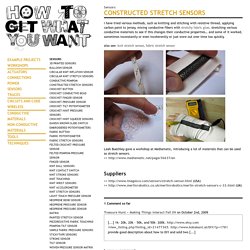
>> Suppliers >> (USA) >> (UK) SensorMania. Homemade patch. Also: neoprene bend sensor, conductive thread Bend Sensor, Bend Sensor (thread) This bend sensor actually reacts (decreases in resistance) to pressure, not specifically to bend.

But because it is sandwiched between two layers of neoprene (rather sturdy fabric), pressure is exerted while bending, thus allowing one to measure bend (angle) via pressure. >> Fabric Bend Sensor Instructable >> Neoprene Bend Sensor IMPROVED Instructable We find that this construction method gives good results (sensitivity) for measuring the bend of human joints when attached to the body. It is sensitive enough to register even slight bend and has a large enough range to still get information when the limbs are fully bent. The neoprene is great for isolating the conductive thread stitches and keeps the sensor from wrinkling even when repeatedly being bend.
The resistance range of this bend sensor depends a lot on the initial pressure. HOW TO GET WHAT YOU WANT. Interweaving layers of conductive fabric, non-conductive fabric, velostat or Eeontex to create a pressure sensitive matrix/grid.
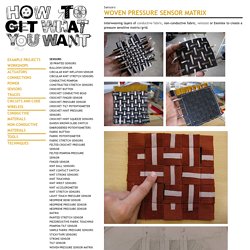
HOW TO GET WHAT YOU WANT. Sewing LED mini pads. If you want to include LED lights in your projects, one of the classic options used to be to wind the legs of a through-hole LED around the tip of a pair of needle-nose pliers, making rings that could then be sewn.
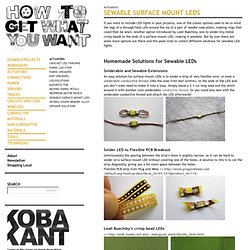
Another option introduced by Leah Buechley, was to solder tiny metal crimp beads to the ends of a surface-mount LED, making it sewable. But by now there are some more options out there and this posts tries to collect different solutions for sewable LED lights. Homemade Solutions for Sewable LEDs Solderable and Sewable Extensions An easy solution for surface mount LEDs is to solder a strip of very flexible wire, or even a solderable conductive thread (like the ones from Karl Grimm), to the ends of the LED and you don’t even need to make it into a loop. Solder LED to Flexible PCB Breakout Unfortunately the spacing between the strip’s holes is slightly narrow, so it can be hard to solder on a surface mount LED without covering one of the holes.
Leah Buechley’s crimp bead LEDs. HOW TO GET WHAT YOU WANT. This is a super simple fabric LED strip with 25 LEDs, LiPo battery power and an on/off switch.
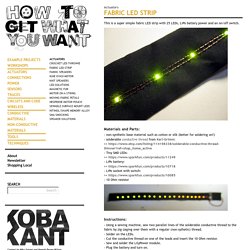
Materials and Parts: - non-synthetic base material such as cotton or silk (better for soldering on!) Techtex. Conductive Thread Pressure Sensor : Materials and tool. HOW TO GET WHAT YOU WANT. This squeeze sensor can be made by knitting or crocheting a ball including resistive yarn.
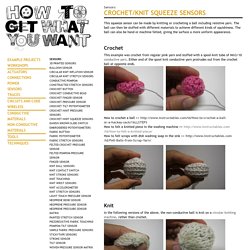
The ball can then be stuffed with different materials to achieve different kinds of squishiness. The ball can also be hand or machine felted, giving the surface a more uniform appearance. Crochet This example was crochet from regular pink yarn and stuffed with a spool-knit tube of Nm3/10 conductive yarn.
Either end of the spool knit conductive yarn protrudes out from the crochet ball at opposite ends. Quilting and eTextiles. Conductive Thread, Homemade Fabric, & LED lights. Conductive fabrics. Also see: Connections >> Solderability Tests There are a range of different conductive fabrics available.
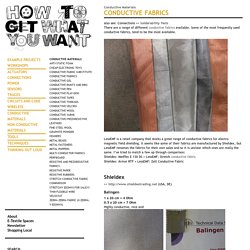
Some of the most frequently used conductive fabrics, tend to be the most available. LessEMF is a retail company that stocks a great range of conductive fabrics for electro magnetic field shielding. It seems like some of their fabrics are manufactured by Shieldex, but LessEMF renames the fabrics for their own sales and so it is unclear which ones are really the same. Free and Dirty Conductive Thread- HOW TO GET WHAT YOU WANT. Welcome to the KOBAKANT DIY Wearable Technology Documentation Workshops least likely scenario This workshop is part of a course at the Ernst Busch Hochschule in Berlin.
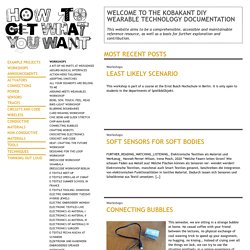
It is only open to students in the departments of Spiel&&Objekt. Workshops soft sensors for soft bodies FURTHER_READING_WATCHING_LISTENING_ Elektronische Textilien als Material und Werkzeug_ Hannah Perner-Wilson, Irene Posch, 2020 “Welche Fasern leiten Strom? Workshops connecting bubbles This semester, we are sitting in a strange bubble at home.
Sensors 6 really wearable sensors The textile sensors on our website are often not designed to be manipulated with your hands. Workshops soft interactive technologies This workshop is a part of a course at the Art Academy Weissensee Berlin. Workshops ETextile Adventures This workshop is part of a course at the Ernst Busch Hochschule in Berlin. Sensors Sole Sensing.